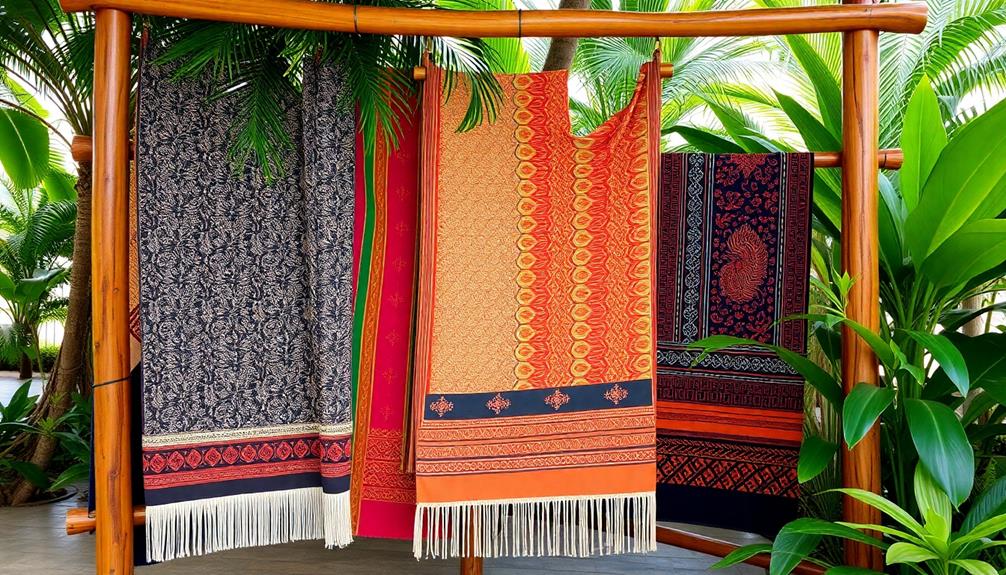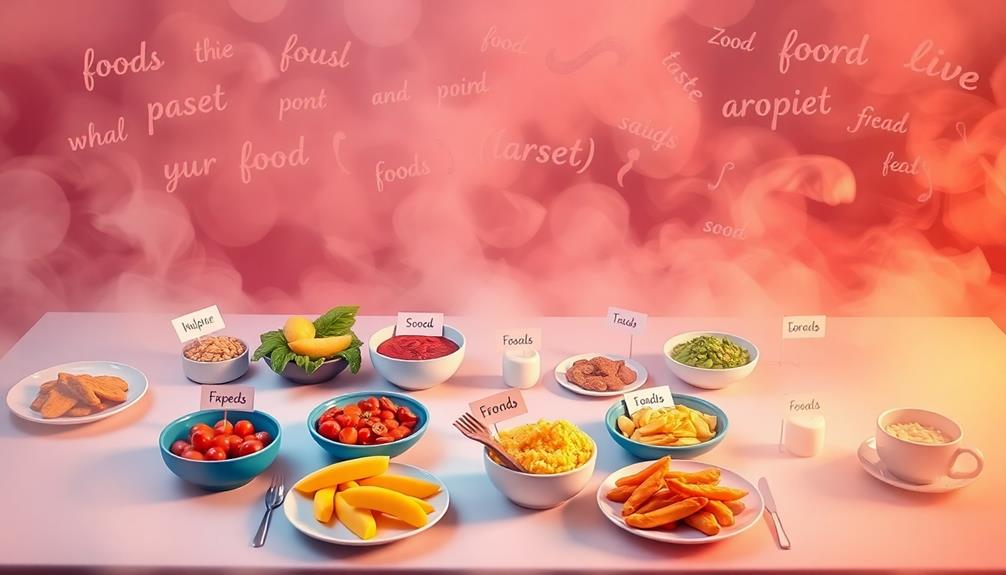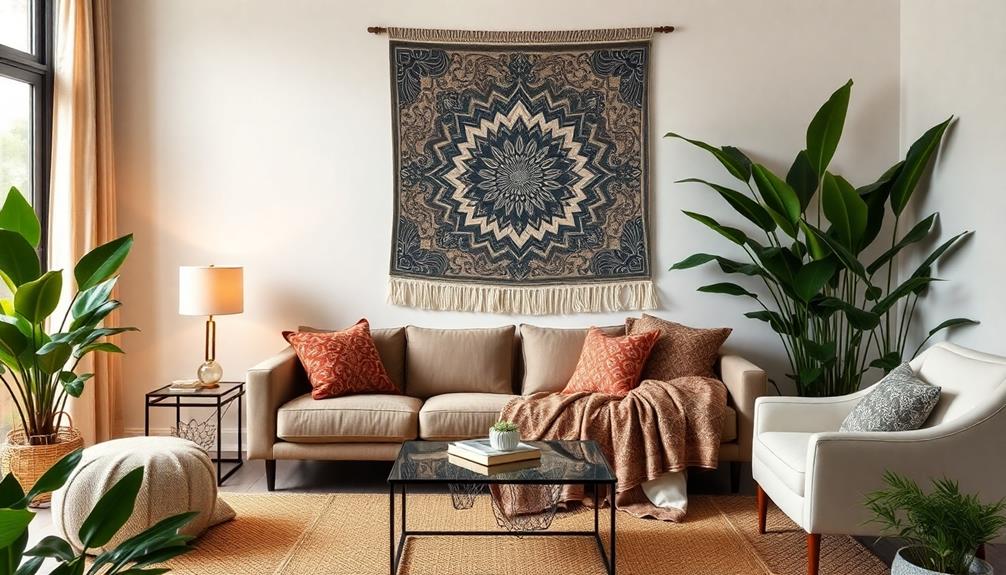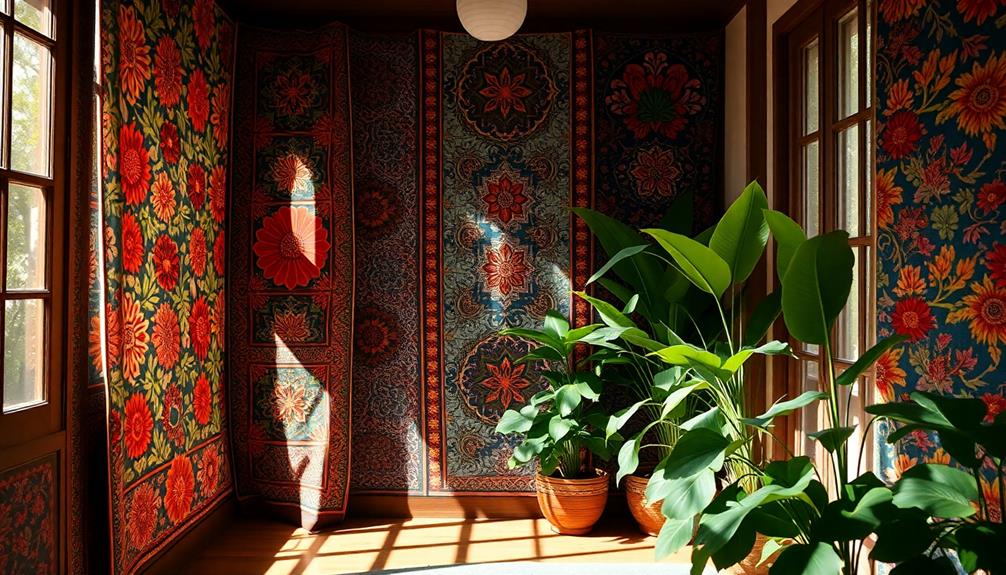The shocking truth about Indonesian textiles is how they seamlessly blend rich heritage with unique craftsmanship. Techniques like Batik, Ikat, and Songket aren't just beautiful; they embody cultural stories and traditions. Each piece reflects local identity and artistry, enchanting designers seeking authenticity. However, fast fashion threatens these traditions, undermining artisans' livelihoods. Yet, many brands champion sustainable practices, promoting ethical production and preserving skills. That's why every designer loves Indonesian textiles—they offer a stunning alternative to the mass market. If you're curious about how these textiles influence modern design, there's so much more to uncover.
Key Takeaways
- Indonesian textiles showcase rich cultural heritage, featuring unique craftsmanship techniques like Batik, Ikat, and Songket that tell stories and reflect local beliefs.
- The decline of traditional practices due to fast fashion highlights the urgent need to preserve textile artistry and empower local artisans.
- Designers are drawn to the intricate patterns and vibrant colors of Indonesian textiles, which enhance contemporary fashion while honoring age-old traditions.
- Sustainable practices, including natural dye usage, promote environmental stewardship and ethical production, making these textiles appealing to conscious consumers.
- Organizations like Threads of Life and KaIND actively empower artisans, ensuring the preservation of skills and providing economic stability within local communities.
The Rich Heritage of Indonesian Textiles

Celebrating Indonesia's vibrant textile heritage reveals a fascinating world of intricate craftsmanship and cultural significance. When you explore Indonesian textiles, you'll discover a rich tradition marked by techniques like Batik, Ikat, Songket, and Tenun. Each style reflects unique regional characteristics and cultural narratives, showcasing the influences of diverse cultures, including Chinese, Indian, Arab, and European.
This tapestry of cultures highlights Indonesia's historical trade routes and vibrant exchanges. Additionally, the artistry of Indonesian decor masks reflects a similar cultural richness, where each piece tells a story of local traditions and values, enhancing the overall aesthetic of any space traditional artistry in masks.
Textiles play an important role in Indonesian ceremonies and rituals, with specific patterns and colors deeply embedded with symbolism that represents community identity and values. As you dive deeper, you'll notice how local wisdom is intricately woven into every piece, emphasizing sustainable practices through the use of natural dyes sourced from local plants.
However, the challenge lies in preserving these traditional techniques. Many senior artisans are retiring, and it's vital for young people to step in and carry on this legacy. Organizations like Threads of Life and KaIND are working to guarantee that these skills are passed down, fostering a new generation that appreciates and upholds Indonesia's rich textile heritage.
Unique Techniques Behind Textile Craftsmanship
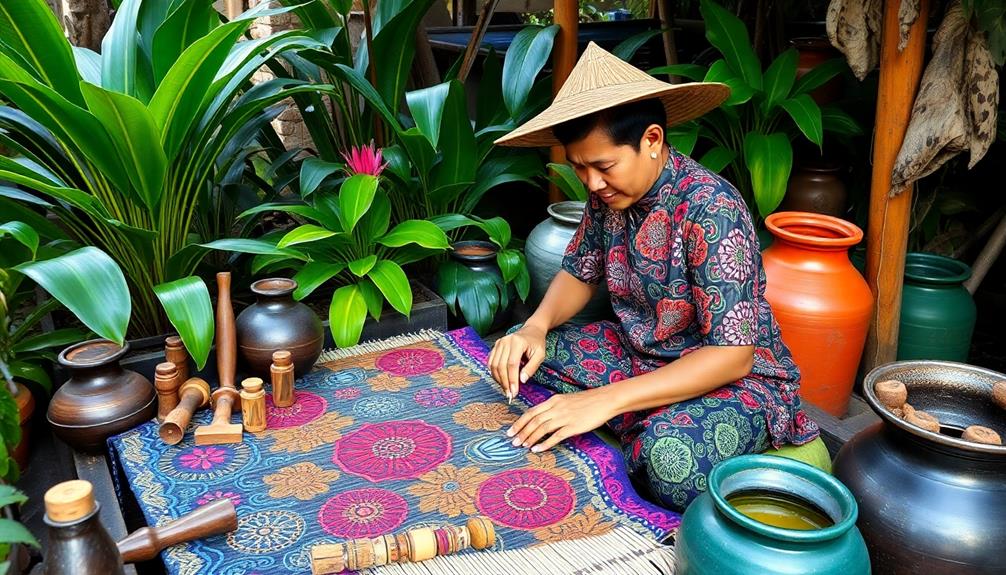
Indonesia's textile craftsmanship showcases a remarkable array of unique techniques that highlight regional diversity and cultural narratives. You'll find that each method tells a story, with Batik's intricate wax-resist dyeing and Ikat's tie-dye applied before weaving standing out. These techniques reflect the artistry and dedication of local artisans, making them highly coveted by designers around the globe.
Here's a quick look at some key techniques:
| Technique | Description |
|---|---|
| Batik | Intricate wax-resist dyeing that creates detailed patterns. |
| Ikat | Tie-dye techniques utilized before weaving for unique designs. |
| Songket | Luxurious patterns crafted with gold and silver threads, signifying status. |
| Natural Dyes | Utilization of local plant-based dyes, promoting sustainability. |
These unique methods not only influence the texture and design but also preserve traditional knowledge passed down through generations. While you may be going away from conventional textile options, embracing Indonesian craftsmanship opens doors to sustainable practices and rich cultural heritage. Each piece you choose symbolizes a story that connects you to its origins, making it more than just fabric.
Cultural Significance and Symbolism
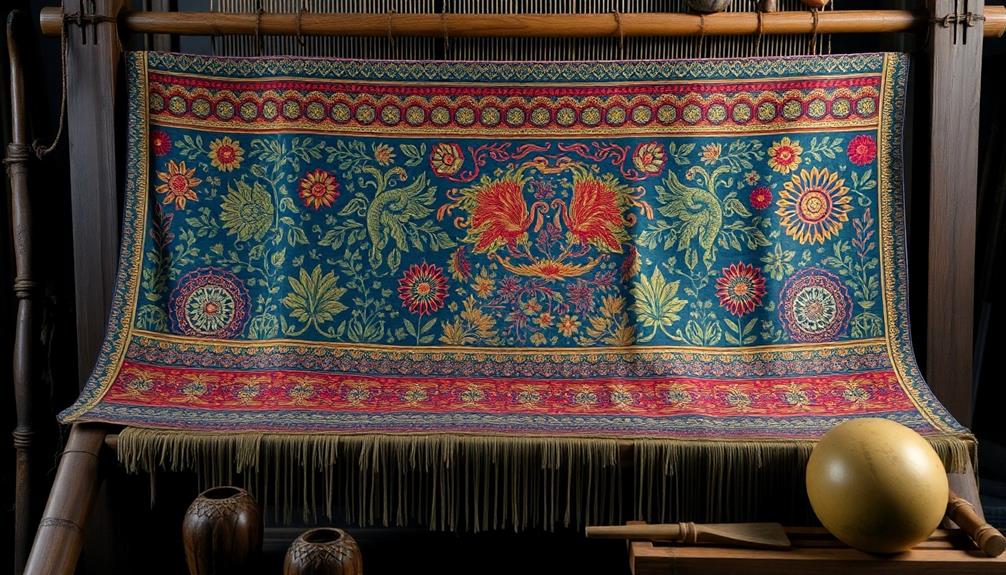
Textiles in Indonesia aren't just fabrics; they embody deep cultural significance and symbolism, reflecting the intricate social structures and community values of the region. Each pattern and motif tells a story, encapsulating the essence of Balinese village life. For instance, the Zumba cloth symbolizes traditional house structures, illustrating the connection between community spaces and individual homes.
Additionally, textiles often feature designs that resonate with unique artistic expressions, further enhancing their cultural importance.
Moreover, specific designs like the Atoni Lafayek from Timor carry profound cultural meanings, with sacred rituals performed during the weaving process to honor these important motifs. This interaction between textiles and spirituality highlights Indonesia's rich heritage.
The intricate red dyeing process, which involves 56 meticulous steps, emphasizes the significance of preserving traditional techniques that form the backbone of cultural identity.
Textiles serve as more than just decorative items; they play an essential role in ceremonies and rites, acting as vessels for stories and beliefs that shape both individual and collective identities.
Regional Diversity in Indonesian Textiles
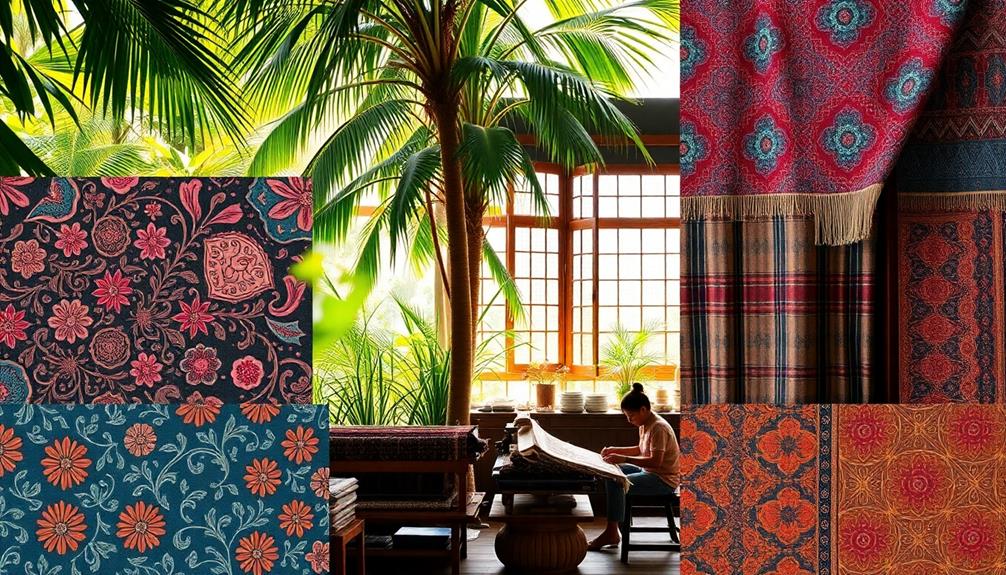
The vibrant tapestry of regional diversity in Indonesian textiles reveals a rich array of styles and techniques, each rooted in its unique cultural narrative.
You'll discover Batik from Java, known for its intricate wax-resist dyeing, which reflects the island's artistic heritage. As you enhance your living spaces, consider incorporating Indonesian decorative pillows that showcase these textiles, adding vibrant colors and intricate patterns to your home.
Then there's Ikat from Flores, where artisans tie-dye the threads before weaving, resulting in stunning patterns that tell stories of local traditions.
As you explore further, you'll encounter textiles from Sumatra, like Songket, characterized by its gold and silver threads, showcasing the craftsmanship of Batak and Lampung regions.
Dayak textiles from Borneo and Toraja fabrics from Sulawesi also capture the essence of their cultures, emphasizing the geographical arrangement that highlights regional traditions.
Don't overlook the rare textiles from remote islands like Sumba and Timor, where local resources and cultural practices influence their production.
Each textile type, whether Batik, Ikat, or Tenun, demonstrates unique regional characteristics and intricate craftsmanship.
Skilled artisans often use natural dyes derived from local plants, preserving techniques passed down through generations.
This regional diversity not only enriches Indonesia's textile heritage but also provides endless inspiration for designers globally.
The Impact of Fast Fashion

Amidst the vibrant heritage of Indonesian textiles, fast fashion casts a shadow, threatening to eclipse centuries of craftsmanship and cultural identity. As you explore the implications, consider the following points:
- Decline of Traditional Practices: Many senior artisans and handweavers are retiring without successors, as interest wanes due to fast fashion's economic pressures. This decline parallels the challenges faced in preserving traditional housing designs, as both artisans and builders struggle against modern trends.
- Impact on Silk Production: Mass-produced textiles diminish the number of silkworm farmers, as cheaper alternatives overshadow traditional silk production. The move towards contemporary aesthetics in textiles often sidelines the intricate methods of traditional craftsmanship.
- Cultural Disruption: The rapid production cycles demanded by fast fashion disrupt local communities, leading to a loss of unique textile heritage and craftsmanship. This mirrors the urbanization trends impacting traditional housing structures, where cultural symbols are increasingly at risk.
- Quality Erosion: Artisans struggle to compete with low prices and quick turnover, resulting in a decline in the quality and uniqueness of traditional textiles.
These factors illustrate how fast fashion not only threatens the livelihoods of skilled artisans but also erodes the rich tapestry of cultural identity that Indonesian textiles represent.
The environmental consequences further complicate the picture, jeopardizing sustainable practices that have been foundational to Indonesian textile production for generations.
It's essential to recognize these impacts and support the preservation of this invaluable heritage.
Community Engagement and Empowerment
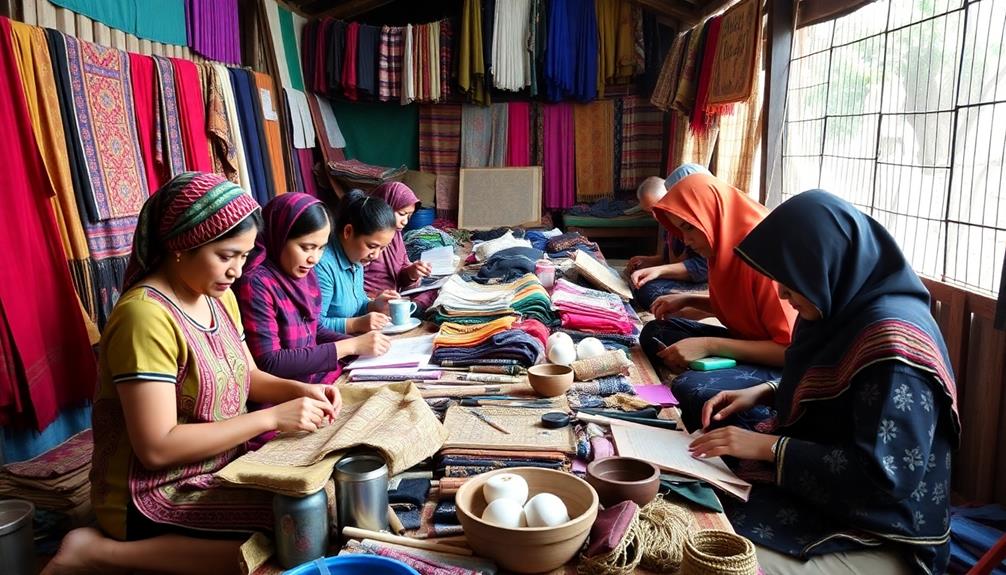
Community engagement and empowerment are essential to preserving Indonesia's rich textile heritage while providing sustainable livelihoods for local artisans. Brands like KaIND actively involve local communities by teaching traditional weaving and batik techniques, which align with the cultural significance of housing and structures found in their region traditional homes as gathering spaces. This approach not only equips individuals with valuable life skills but also guarantees they receive regular salaries, fostering economic stability.
Threads of Life takes this a step further by collaborating with over 1,000 weavers across 12 Indonesian islands. Their focus on preserving traditional textile production greatly supports community livelihoods and empowers women, creating a ripple effect of positive change.
You'll notice that young artisans at KaIND learn directly from senior weavers, promoting a mentorship model that enhances craftsmanship and instills pride in their unique, handcrafted textiles.
The emphasis on community engagement in initiatives like KaIND and Threads of Life not only helps preserve cultural heritage but also assures that textile production remains a viable source of income for marginalized groups.
Through these collaborative efforts, artisans are empowered to maintain their traditions while improving their economic prospects, guaranteeing that Indonesia's vibrant textile legacy continues to thrive for generations to come.
Sustainable Practices in Textile Production
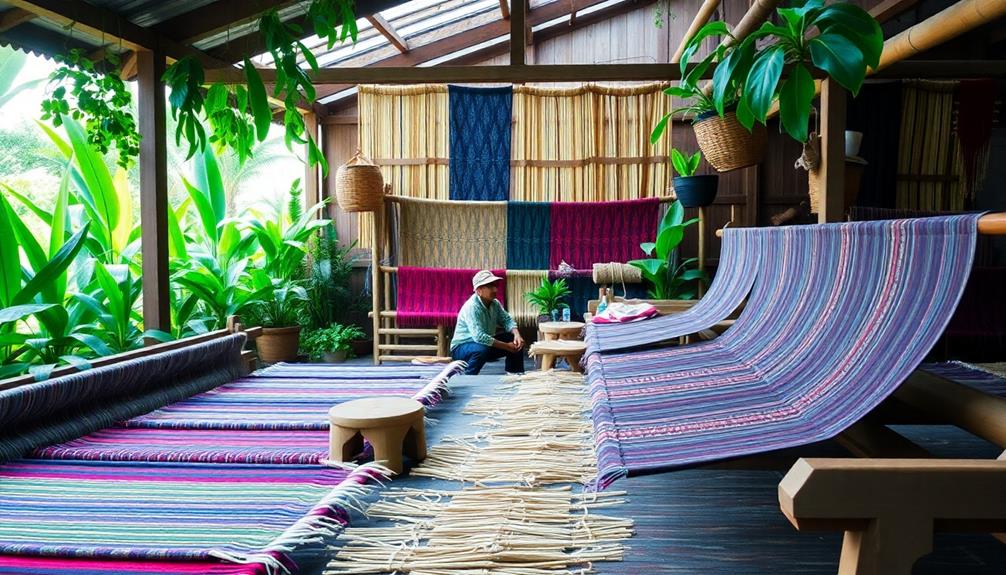
In Indonesia, sustainable practices in textile production are deeply rooted in tradition and environmental consciousness. You'll find that many artisans utilize natural dyes from local plants, which not only minimizes chemical use but also enhances the beauty of their textiles.
Additionally, the intricate designs often reflect the rich cultural heritage of Indonesia, similar to the craftsmanship seen in their Indonesian decor masks.
Here are some key practices you should know about:
- Natural Dyes: Artisans use plant-based dyes, reducing reliance on harmful chemicals.
- Traditional Weaving: Many techniques are passed down through generations, ensuring eco-friendly production without electricity.
- Community Engagement: Brands like KaIND teach sustainable weaving and provide fair wages, supporting local economies.
- Livelihood Preservation: Organizations like Threads of Life work with over 1,000 weavers, protecting traditional methods and promoting sustainable livelihoods.
These practices create a low carbon footprint while fostering economic and ecological sustainability.
By choosing Indonesian textiles, you're not just investing in unique designs; you're also supporting a culture that prioritizes the planet's health.
Embracing sustainable practices means you'll contribute to a future where artistry and environmental stewardship coexist harmoniously.
Designers' Fascination With Indonesian Textiles
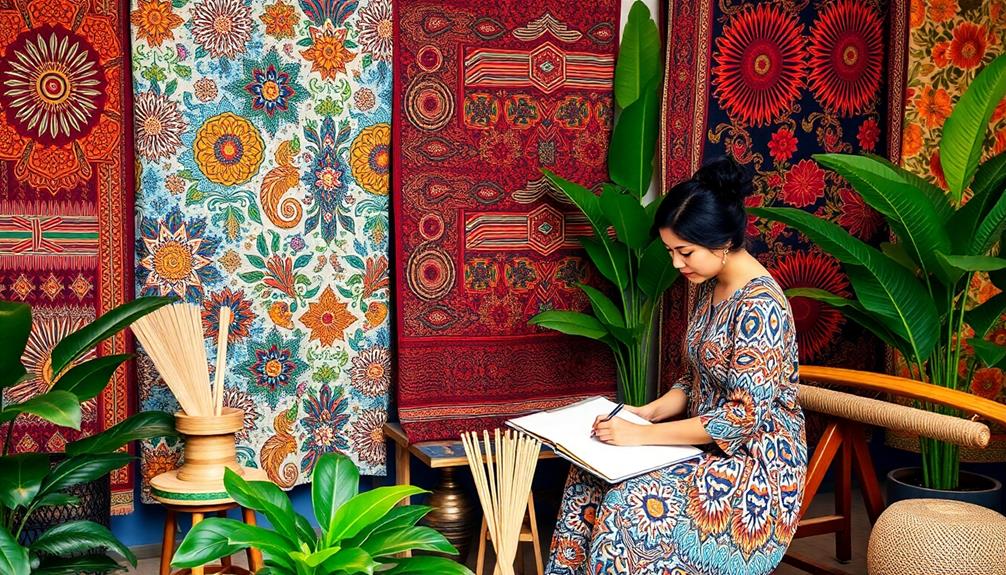
You can't help but notice how Indonesian textiles captivate designers with their rich cultural heritage and unique craftsmanship techniques.
These fabrics not only tell stories tied to communities and traditions but also align with sustainable fashion practices that prioritize eco-friendliness.
The use of traditional textiles in interior design, such as in traditional Indonesian style home decor, showcases the intricate patterns and colors that enhance any space.
As you explore this fascinating intersection, you'll see how these elements inspire contemporary fashion while preserving age-old artistry.
Cultural Heritage Preservation
Designers are increasingly captivated by Indonesian textiles like Batik, Ikat, and Songket, drawn to their intricate craftsmanship and rich cultural narratives.
These textiles aren't just fabric; they encapsulate centuries of tradition and storytelling that designers find irresistible.
Additionally, the use of natural materials and traditional craftsmanship resonates with the principles of Balinese design characteristics that emphasize sustainability and a connection to culture.
Here's why they're so passionate about preserving this cultural heritage:
- Cultural Significance: Each textile is steeped in symbolism, reflecting local beliefs and rituals that designers want to showcase.
- Empowerment: Organizations like Threads of Life support over 1,000 artisans, particularly women, helping them maintain their craft while providing sustainable livelihoods.
- Sustainable Practices: The use of natural dyes from local plants highlights environmental stewardship, aligning with designers' values for ethical sourcing.
- Unique Identity: In a world dominated by fast fashion, Indonesian textiles offer a unique, culturally rich alternative that stands out in contemporary collections.
Unique Craftsmanship Techniques
Engaging craftsmanship techniques in Indonesian textiles draw the attention of fashion designers worldwide. You'll find that textiles like Batik and Ikat showcase intricate methods, such as wax-resist dyeing and tie-dyeing, which captivate with their unique artistry and complexity.
Each type reflects regional characteristics and cultural heritage, with Batik featuring detailed patterns while Ikat is known for its blurred edges and vibrant colors. The rich cultural significance of these textiles is often mirrored in traditional motifs and patterns, enhancing the storytelling aspect in design.
Designers are keen to incorporate these textiles into their collections because of the rich palette of colors derived from natural dyes sourced from local plants. These hues not only appeal to your aesthetic sensibilities but also align with eco-conscious values.
Traditional weaving techniques, passed down through generations, add authenticity and cultural significance, attracting designers who respect heritage and craftsmanship.
Additionally, the skilled artisans behind these textiles have undergone years of training, ensuring each piece tells a story of cultural identity. For designers, this narrative element is invaluable, as it allows you to weave deeper meaning into your creations.
Sustainable Fashion Practices
The intricate craftsmanship of Indonesian textiles naturally aligns with sustainable fashion practices, capturing the interest of designers who prioritize ethical production. The rich cultural heritage evident in these textiles is reminiscent of the luxury tropical design aesthetics found in Bali.
Here's why these textiles stand out:
- Natural Dyes: Indonesian artisans use dyes derived from local plants, ensuring eco-friendly color options that minimize environmental impact.
- Community Engagement: Brands like KaIND focus on slow fashion by working closely with local communities, providing fair wages and life skills while preserving cultural heritage.
- Women Empowerment: Threads of Life collaborates with over 1,000 female weavers, enhancing their livelihoods and ensuring the continuation of traditional textile practices.
- Unique Aesthetics: The distinct textures and styles of handwoven fabrics are unmatched by machines, giving designers a unique touch that elevates their collections.
These sustainable practices, such as using traditional looms without electricity, contribute to the growing appeal of Indonesian textiles.
As a designer, you're not just choosing a fabric; you're embracing a movement toward responsible fashion that honors artisans and the environment alike. Your commitment to sustainability can truly shine through when you incorporate these beautiful and ethically-produced textiles into your work.
Future of Indonesian Textile Traditions
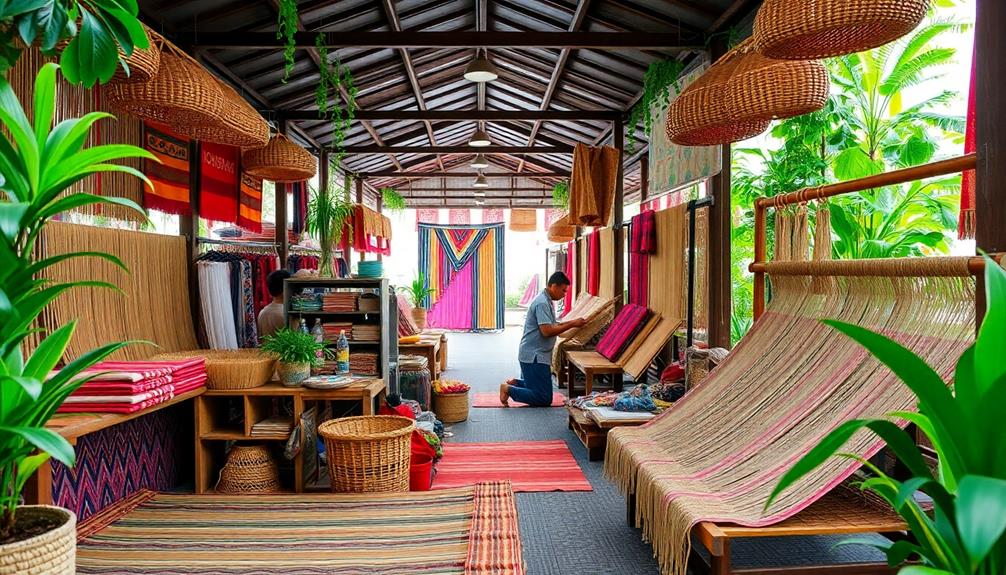
As interest in traditional textile practices grows, the future of Indonesian textile traditions looks promising, particularly with initiatives aimed at preserving artisanal skills. Organizations like Threads of Life empower over 1,000 weavers, ensuring their livelihoods through cultural education and community engagement. This commitment to preserving artisanal skills is imperative.
You'll be glad to know that young generations are stepping up, enthusiastic to learn traditional techniques, especially in dye work. Take, for instance, the meticulous documentation of a complex red dye process outlined in 56 steps, ensuring the knowledge is passed down effectively.
Initiatives such as KaIND are revitalizing local textile wisdom by involving communities in handwoven batik and weaving techniques. These programs not only impart life skills but also create economic opportunities for marginalized groups.
Moreover, the focus on sustainable practices and natural materials is essential as the industry counters the negative impact of fast fashion while protecting cultural heritage.
Collaborations between local artisans and small enterprises are fundamental for expanding the reach of traditional textiles, promoting slow-fashion products, and ensuring that these invaluable traditions thrive in a modern context.
Frequently Asked Questions
What Is the Indonesian Textile Technique?
Indonesian textile techniques include Batik, Ikat, and Songket. You'll appreciate Batik's intricate wax-resist dyeing, Ikat's unique tie-dye weaving, and Songket's luxurious threading, each reflecting rich cultural heritage and skilled craftsmanship from generations of artisans.
What Is the Most Famous Textile of Indonesia?
When it comes to Indonesia's rich textile heritage, Batik stands out as a celebrated masterpiece. Its intricate patterns and vibrant colors weave tales of culture, making it a cherished symbol of identity and artistry.
Why Are so Many Clothes Made in Indonesia?
So many clothes are made in Indonesia because of its skilled artisans, rich textile traditions, and competitive labor costs. You'll find unique designs and sustainable practices that appeal to both designers and eco-conscious consumers alike.
What Is the Fabric Design in Indonesia?
Indonesian fabric designs are a vibrant tapestry woven from cultural threads. You'll discover Batik's intricate patterns, Ikat's blurred beauty, luxurious Songket, and Tenun's rich textures, each reflecting the nation's diverse heritage and craftsmanship.
Conclusion
In the vibrant tapestry of Indonesian textiles, you find not just fabric, but stories woven with culture, history, and passion. As designers embrace these rich traditions, they're not just creating; they're reviving a legacy. Isn't it fascinating how each thread tells a tale of resilience and artistry? By supporting these artisans, you're not only wearing unique pieces but also becoming part of a movement that champions sustainability and community. Together, let's keep these remarkable traditions alive for generations to come.
